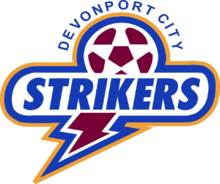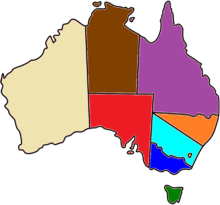Devonport City FC
 | ||
| Full name | Devonport City Soccer Club | |
|---|---|---|
| Founded | 1966 (Amalgamated in 1982) | |
| Ground | Valley Road Ground | |
| Capacity | 3,500 (Record Crowd – 3,168) | |
| Manager | 2016 – Peter Savill | |
| League |
NPL Tasmania & Northern Championship | |
| 2016 | 1st (NPL) | |
|
| ||
Devonport City Football Club, or the "Strikers" is a soccer club which is based in Devonport, Tasmania. It currently competes in the National Premier Leagues Tasmania.
The club currently plays at Valley Road Ground which normally seats 1250. But it has gone up to close to 2500 in FFA Cup games. The venue is located in Devonport, Tasmania. The club also fields teams in all junior divisions, as well as women's teams. Devonport City was formed in 1982 as an amalgamation of Devonport and Devonport Rovers, and has become a successful side winning the state title 5 times with the recent one being in 2016.
History
1950s
1950– Soccer starts on the North West Coast. A meeting was held in the Bay View Hotel in Burnie to form an association. As a result of the meeting four teams were formed. APPM, Burnie Celtic, Penguin and The Advocate. The Advocate team folded soon after due to a lack of players.
1952– Devonport united plays in the NWTSA. Little is known or recorded about the history of soccer in Devonport but a team formed by Norman Holmes played in the North-West league in 1952. Norman Holmes is a life member of the Devonport City Soccer Club. Games were played at St George’s oval. A team from Railton also played in the Coastal roster. Teams were APPM, Burnie Celtic, Penguin, Devonport and Railton.
1954– It is not known why but Devonport and Railton did not participate in the 1954 Roster
1960s
1961– It was not until 1961 that Devonport United was officially established at the well attended meeting on Wednesday May 3. The club affiliated with the NWTSA and joined the roster on June 3. Devonport United made an impressive debut when held by the strong Ulverstone side to a 2–1 loss. The Ulverstone Club was also formed in 1961 and played from the start of the season. Members of the original Railton Club donated their blue and gold boxed square strip to the newly formed Devonport Club. Home games were played at the Devonport Showgrounds and at the Spreyton Racecourse.
1965– Devonport United moved to Byard Park and shared the ground with the newly formed Mersey Soccer Club. The old wooden shed that was used as change rooms had no toilet facilities, no electricity and no showers. Monthly meetings were held with the use of lanterns. In 1965 the clubs requested Devonport Council to have Byard Park fenced as the clubs desperately needed an enclosed ground. The council replied that Byard Park, when purchased from the Byard family had to remain open parkland and the development of a Soccer Centre at Coles Beach road would be to the advantage of both clubs interests.
1966– August. Devonport United and Mersey ask the council for a date for the start of development at Coles Beach. In November, Mersey and Devonport amalgamated at a special meeting held at the Adult Education Centre. The main objective was to continue discussions with council for a ground for the exclusive use of soccer.
1967– August. Council advise that the Coles Beach plan has to be abandoned because the area was insufficient in size for the full development. As an alternative council have plans for a soccer centre to be located on the newly acquired Baptist Church property in the Valley Road area. Pending completion of these plans the possibility of the club using Girdlestone Oval on alternative Saturdays to the East Devonport Football Club was pro-posed.
1968– October. Council writes and asks what financial assistance the club is prepared to make towards the establishment of Valley Road. The club offers $600 per year.
1969– April 14. In a lengthy letter from the clubs Secretary, Ernie Armsby writes- “Negotiations have been proceeding with council for several year and members are losing heart that a soccer centre would not eventuate and suggest making St. Georges Oval their permanent home. The club will accept responsibility for erecting the fence.” On April 18 the council writes that Spreyton Racecourse Committee agree to using the ground. On May 1 the council writes that St George Oval be set aside as future headquarters. On June 13, the council advises that they have received an objection from a resident in East Devonport to a fence and the council offers the use of Don Cricket Clubs grounds. The Cricket Club agrees. On October 23, Council Executive and Soccer Club representatives meet to discuss developments. On October 28, we have pleasure in advising that the council authorises the immediate development on a Soccer Centre in the Valley Road area.
1970s
1970– March 13 the council considers tenders for the construction of change rooms at Valley Road for the sum of $16,561. Wilkins, Grey and Dowling are contracted to complete construction by May 29. In August, the Club asks the council to start work on the playing area.
1971– July 18. Devonport Soccer Club uses Valley Road for the first time. The club experiences difficulties because of the approach path from Valley Road. (At this time Lovett St did not exist.)
1972– March. The soccer club seeks council permission to erect lights for training. Cost $3,000
1972– June 3 Valley Road Soccer Centre is officially opened by Councillor Percy Williams, Warden of Devonport. Devonport beats Hobart Metro 3–2 in an Ampol Cup Game on the opening day and soccer in Devonport came of age. Later in 1972, Lovett Street was constructed and the Valley Road Soccer Centre was open to traffic.
1973– September. Soccer Club runs Night Soccer Series sponsored by Norco Batteries and The Advocate Newspaper.
1975 – Australian Federal Government announces “Red Scheme”, an initiative where sporting clubs could apply for building projects. The Soccer Club applies and is granted $13,795 for clubroom extensions. The club erects a grand stand which costs $12,000. They also upgrade floodlights on the main ground and erect lights on the training ground. The cost of which is $20,000 from club funds.
1976– May 16. Bingo starts and becomes so popular that the club obtains a loan from the council for $40,000 for extensions. Plans included an office and a large lounge area. Further extensions were necessary and a loan of $30,000 was obtained from the ANZ Bank. During the 1980’s Devonport City welcomed overseas coaches. In 1980, Steve Darby from Liverpool. In 1982, Bob Oates from Scunthorpe and in 1985, Phil Ashworth from Rochdale.
1980s
1987– The Club hosts the National Under 14 Carnival from September 26 to October 4. Many visitors comment that this was one of the best carnivals they had ever taken part in. It was an exceptional and memorable event. Socceroos goalkeeper, Mark Schwarzer played for NSW in the tournament.
1987– October 13 at 1:30am FIRE DESTROYS CLUBROOMS. Sadly, eight days after the carnival ended, the Devonport City Soccer clubrooms were burnt to the ground. Total Damage in excess of $350,000.
1987– October 17. The Club meets the Council’s Executive to apply for a Tasmanian Government Grant. A $220,000 grant was approved and along with $275,000 insurance on the destroyed clubrooms plans were drawn up for a new clubroom with a total cost of $475,000. Work started on March 4, 1988 and were completed on August 30. The club was officially opened by the Hon. Tony Rundle, MHA on September 10. The club rooms and contents were valued at $650,000.
1989– George Best, rated as one of the world’s best soccer players visits Devonport. About 1000 soccer fans from throughout Tasmania converged on Valley Road to see George Best in action. George Best, former Manchester United and Northern Island player came out for Devonport City against a strong Tasmanian side. The match ended in a 2–2 draw.
2010s
On July 2012, the club was granted admission into the new 8-team statewide league called the Victory League.[1] The competition which started in 2013 would soon become the National Premier Leagues Tasmania in 2016 with the club taking home their first title after they defeated the Northern Rangers FC in the second to last round of the season. The team also qualified for the FFA Cup proper (round of 32) for the first time by beating South Hobart 1–0 in the final of the Lakoseljac Cup. They would take on the Lambton Jaffas at home and they won by a score of 1–0 to become the first Tasmanian team to reach the next round of the cup.[2]
Seasons
| Season | League | Statewide Cup | FFA Cup | |||||||||||
|---|---|---|---|---|---|---|---|---|---|---|---|---|---|---|
| Name (national level) | Pld | W | D | L | GF | GA | GD | Pts | Position | Tasmanian Finals | NPL Finals | |||
| 2013 | Victory League (2) | 21 | 13 | 2 | 6 | 68 | 38 | 30 | 41 | 2nd | Final | DNQ | Quarter Finals | N/A |
| 2014 | Victory League (2) | 21 | 9 | 2 | 10 | 49 | 49 | 0 | 29 | 5th | DNQ | DNQ | Quarter Finals | DNQ |
| 2015 | Victory League (2) | 21 | 6 | 3 | 12 | 42 | 51 | −9 | 21 | 7th | DNQ | DNQ | Round of 16 | DNQ |
| 2016 | NPL Tasmania (2) | 21 | 19 | 1 | 1 | 61 | 10 | +51 | 58 | 1st | Runners-up | Quarter Finals | Winners | Round of 16 |
Honours
- Milan Lakoseljac Cup: 3 times (1977, 2002, 2016)
- State Championships: 5 times (1994,1998,2003,2004,2016)
- State Championships Runners-up: 2 times as Devonport (1974,1977)7 times as Devonport City (1982,1983,1992,1993,1997,2002,2008)
- Northern Premierships: 5 times (2000,2002,2003,2004,2008) 4 times as Devonport Rovers (1985,1987,1988,1989) 2 times as Devonport (1974,1977)
